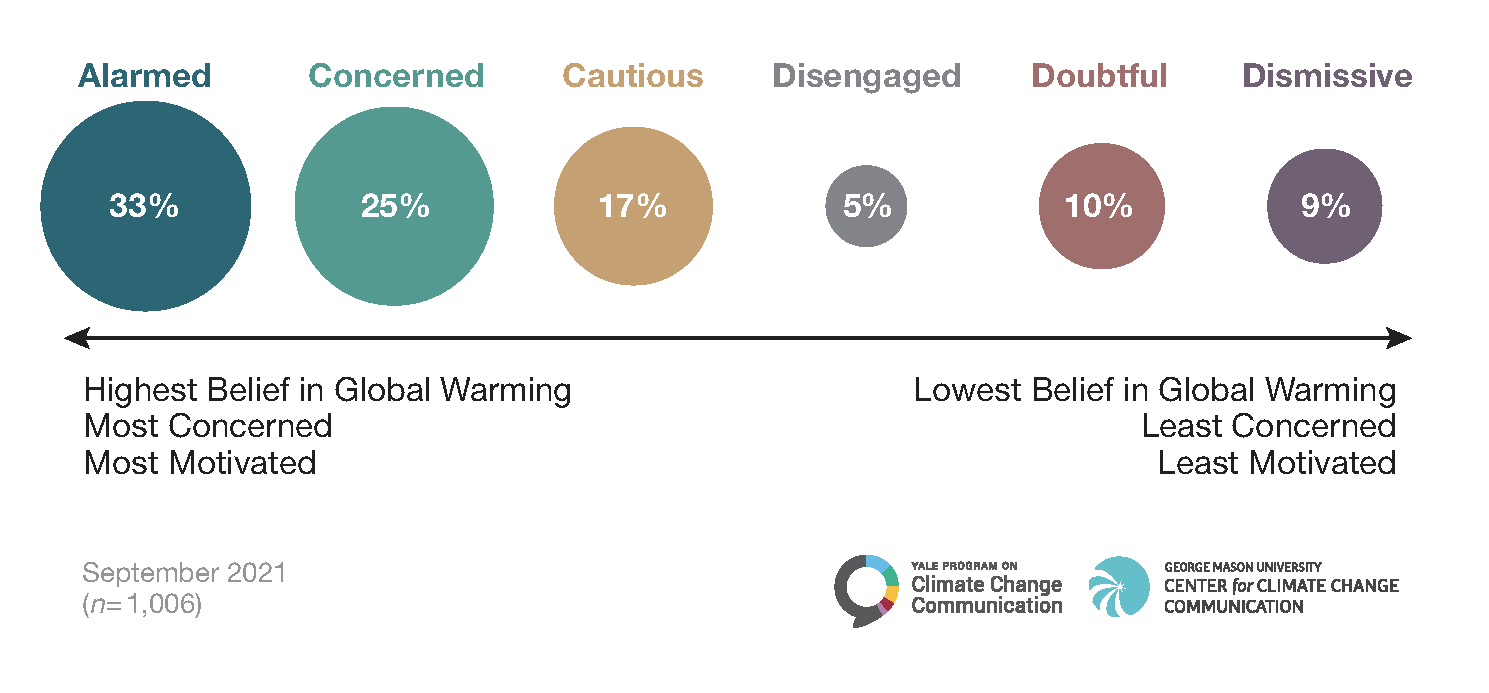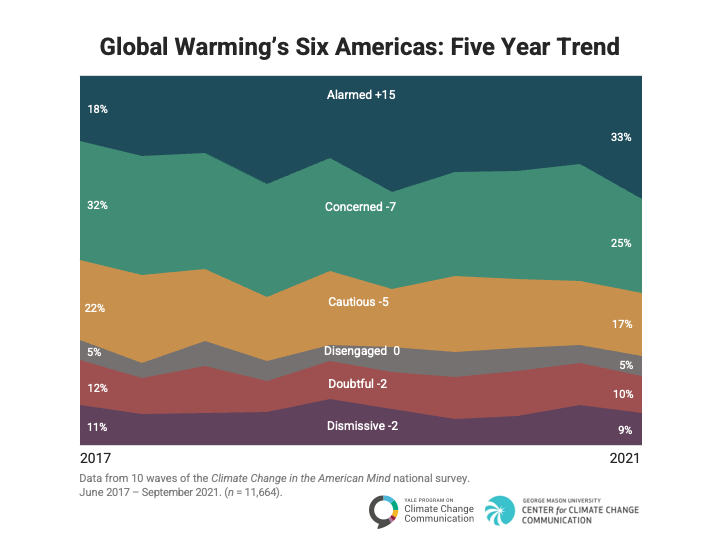Climate Note · Jan 12, 2022
Global Warming’s Six Americas, September 2021
By Anthony Leiserowitz, Edward Maibach, Seth Rosenthal, John Kotcher, Liz Neyens, Jennifer Marlon, Jennifer Carman, Karine Lacroix and Matthew Goldberg
Filed under: Audiences and Beliefs & Attitudes
Our prior research has found that Americans can be categorized into six distinct groups—Global Warming’s Six Americas—based on their beliefs, attitudes, policy support, and behavior about climate change.
The Alarmed are the most engaged, are very worried about global warming, and strongly support climate action. The Concerned think global warming is a significant threat but prioritize it less and are less likely to be taking action. The Cautious are aware of climate change but are uncertain about its causes and are not very worried about it. The Disengaged are largely unaware of global warming, while the Doubtful doubt it is happening or human-caused and perceive it as a low risk. The Dismissive firmly reject the reality of human-caused global warming and oppose most climate change policies.
 Today, the Alarmed (33%) outnumber the Dismissive (9%) by more than 3 to 1. About six in ten Americans (59%) are either Alarmed or Concerned, while only about 2 in 10 (19%) are Doubtful or Dismissive.
Today, the Alarmed (33%) outnumber the Dismissive (9%) by more than 3 to 1. About six in ten Americans (59%) are either Alarmed or Concerned, while only about 2 in 10 (19%) are Doubtful or Dismissive.
The Six Americas Over Time
There has been substantial change in the distribution of the Six Americas over the past five years. The Alarmed segment has nearly doubled in size, increasing 15 percentage points (from 18% to 33% of the U.S. adult population), including an increase of 9 percentage points from March 2021 to September 2021. In contrast, over the past 5 years only about 1 in 10 Americans have been Dismissive (decreasing from 11% to 9%). Overall, Americans are becoming more worried about global warming, more engaged with the issue, and more supportive of climate solutions.
 When our surveys began in 2008, the Concerned were the single largest group. By 2010, they were slightly smaller, while the Cautious grew and became about equally as large. By contrast, the Alarmed were the second smallest group as recently as early 2015 (only the Disengaged were smaller), but have grown rapidly to become the largest segment of the U.S. population today. Meanwhile, the Cautious, Doubtful, and Dismissive groups have all gotten smaller in recent years.
When our surveys began in 2008, the Concerned were the single largest group. By 2010, they were slightly smaller, while the Cautious grew and became about equally as large. By contrast, the Alarmed were the second smallest group as recently as early 2015 (only the Disengaged were smaller), but have grown rapidly to become the largest segment of the U.S. population today. Meanwhile, the Cautious, Doubtful, and Dismissive groups have all gotten smaller in recent years.
Communication Challenges
Americans’ understanding of global warming’s reality and risks, and support for climate action is growing. The growth of the Alarmed segment, in particular, is encouraging because progress on climate change requires strong, coordinated, and sustained action, and the Alarmed are the most likely to demand and support these actions by leaders. Yet, this potential “issue public” still needs to be organized and mobilized to demand action at all levels of American society.
The Concerned and Cautious (42% of U.S. adults) do not yet fully understand the threat of climate impacts or the urgency of climate action, despite the fact that global warming is already harming communities across America – including increasingly extreme weather, impacts on human health, and human and economic disasters. However, there is also strong public support – across party lines – for a variety of climate policies.
Resources and Data
The Six Americas Survey (SASSY), a short, four-question online quiz, allows users to determine which segment they belong to (Chryst et al., 2018). Quiz results also illustrate how the respondent’s views about global warming compare with those of other Americans.
The SASSY Group tool allows users to upload their own data (e.g., from a class, one’s own survey, members of an organization, etc.). The tool calculates the Six Americas segment for each individual in the dataset and provides a downloadable spreadsheet and summary graphics.
The Six Americas data are from the twice a year Climate Change in the American Mind surveys conducted in partnership with our colleagues at the George Mason University Center for Climate Change Communication.
Methods
These data were produced from the Climate Change in the American Mind survey, a nationally-representative survey of public opinion on climate change in the United States conducted by the Yale Program on Climate Change Communication and the George Mason University Center for Climate Change Communication. Surveys were conducted from October 2008 to September 2021 using the Ipsos KnowledgePanel®, a representative online panel of U.S. adults (18+). All questionnaires were self-administered by respondents in a web-based environment.
Average margin of error for each wave: +/- 3 percentage points at the 95% confidence level. Percentage values are weighted to align with U.S. Census parameters. For tabulation purposes, percentage points are rounded to the nearest whole number. Additionally, summed categories (e.g., Alarmed + Concerned) are rounded after sums are calculated (e.g., 33.4% + 25.3% = 58.7%, which, after rounding appears in this report as 33% + 25% = 59%).
